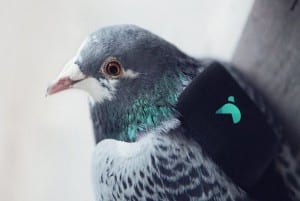 Many birds travel in flocks, but the question of how they choose the leader has long puzzled scientists.
Many birds travel in flocks, but the question of how they choose the leader has long puzzled scientists.
Now a team of researchers led by Mr Benjamin Pettit from Oxford University think they have the answer.
They fitted four flocks of 10 homing pigeons with small data logging backpacks and sent them on a series of group and solo flights.
These tracked not only the birds’ skill in making a beeline for home, but also measured their ability to influence the flock’s direction by recording the fractional time delays it takes one bird to react to another when flying together.
Some birds are naturally faster and consistently get to the front, where they end up doing more of the navigation, which means on future flights they know the way better.
Associate Professor Dora Biro
The researchers found that when the birds flew a route on their own for the first time those identified as leaders were no better than followers in forging a direct route home to their roost. But when the birds were tested individually after they had flown the route as part of a flock, leaders were found to have learned straighter homing routes than followers.
“Some birds are naturally faster and consistently get to the front, where they end up doing more of the navigation, which means on future flights they know the way better,” said study co-author Associate Professor Dora Biro, also of Oxford University.
“You can compare this to a ‘passenger-driver’ like effect: drivers in a car have to pay attention while passengers are often unable to recall the route they were driven along, especially if they remained passive in the navigation process.”
The finding, published in Current Biology, changes our understanding of how the flocks are structured and why pigeons have consistent leadership hierarchies, the researchers said.
Are leaders born or made?
Previous research had shown that leaders were not necessarily the most successful breeders or those with more social affiliations (friends) in the flock. Giving followers extra training flights does not promote them into a leadership position either.
Researcher releasing pigeon
PHOTO: Even when the pigeons were released from different locations the same pigeons led the flock (Zsuzsa Akos)
Instead, pigeons build on their natural strengths – in this case flight speed – to become leaders, said the researchers.
“Flight speed is correlated with body size, pectoral muscle mass and so on, but not necessarily with competence at solving the task at hand,” Dr Biro said.
“But we found that leaders learnt more during navigational problem-solving than followers, and as a result became better informed leaders.
“This suggests a positive feedback between leadership and competence, where leaders become increasingly more competent at leading – in a sense, they are ‘made’ into better leaders by being forced to lead in the first place.”
Even when the birds were released from new locations the same birds tended to lead, added Mr Pettit.
Could pigeon leadership apply to other birds?
Mr Pettit said the research demonstrated leadership hierarchies could arise from individual differences driven by a simple mechanism such as speed.
“In this case, the slower birds lag slightly behind and end up following their faster flock mates. Leadership does not require complex social interactions,” he said.
The findings indicated we would expect to find leadership in a wide variety of species that travel in groups, he said.
You may also like …
‘Protein compass’ may explain how pigeons find their way home
Pigeons identify breast cancer
However other factors would also come into play in migratory species.
“It depends on the variation in experience within the flock,” Mr Pettit said.
“In our experiment, the pigeons all had roughly the same level of experience, having never been released from those sites before. If some flock members have much more experience than others, for example migratory flocks with a mix of ages, then experience is probably a larger determiner of leadership.
“Another consideration is that in v-shaped flocks, flying in front is more energetically costly, so birds such as pelicans, ibises, and geese might have different patterns of leadership for that reason.”
About Pigeon Patrol:
Pigeon Patrol Products & Services is the leading manufacturer and distributor of bird deterrent (control) products in Canada. Pigeon Patrol products have solved pest bird problems in industrial, commercial, and residential settings since 2000, by using safe and humane bird deterrents with only bird and animal friendly solutions. At Pigeon Patrol, we manufacture and offer a variety of bird deterrents, ranging from Ultra-flex Bird Spikes with UV protection, Bird Netting, 4-S Gel and the best Ultrasonic and audible sound devices on the market today.
Voted Best Canadian wholesaler for Bird Deterrent products four years in a row.
Contact Info: 1- 877– 4– NO-BIRD (www.pigeonpatrol.ca)

